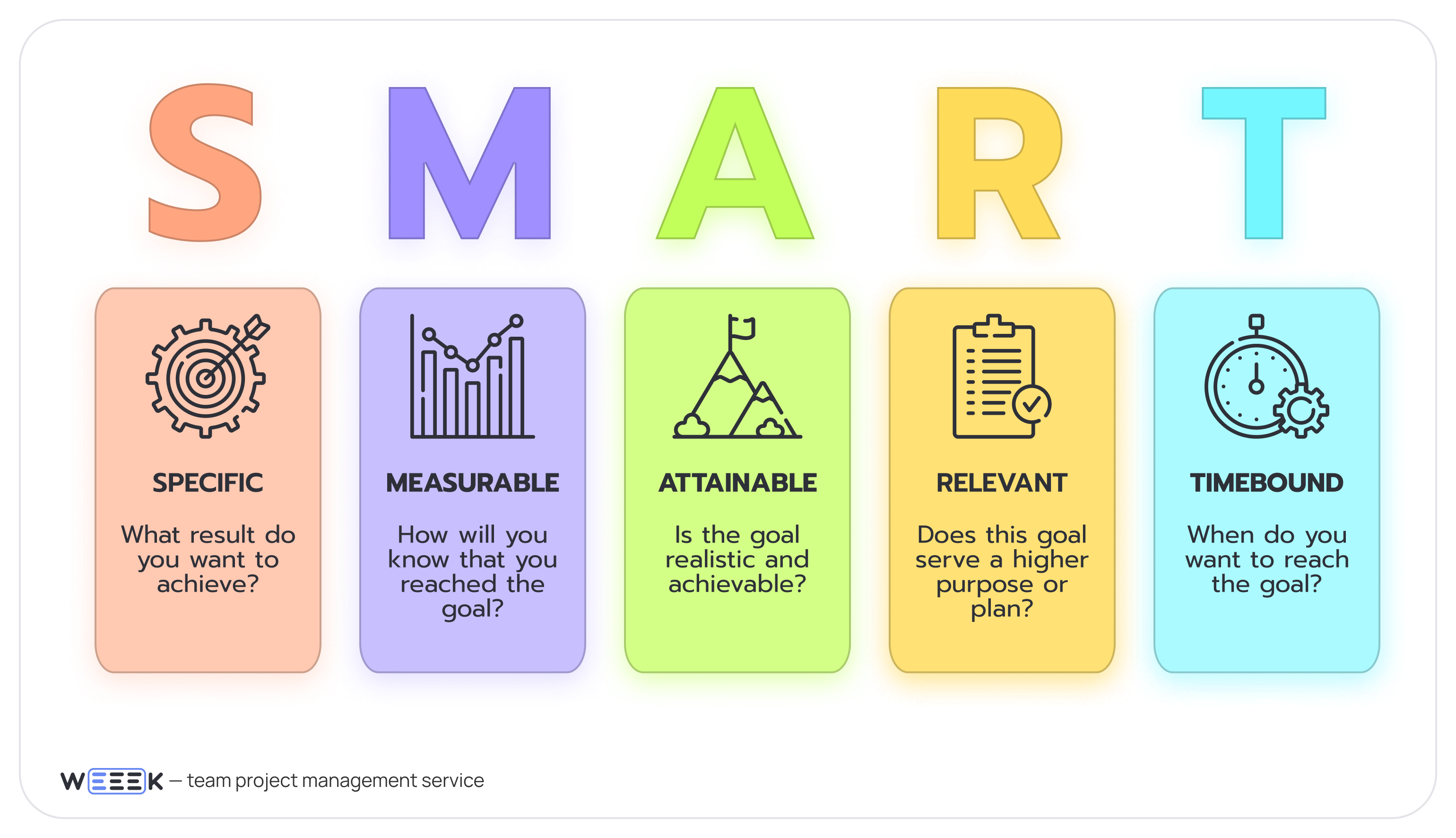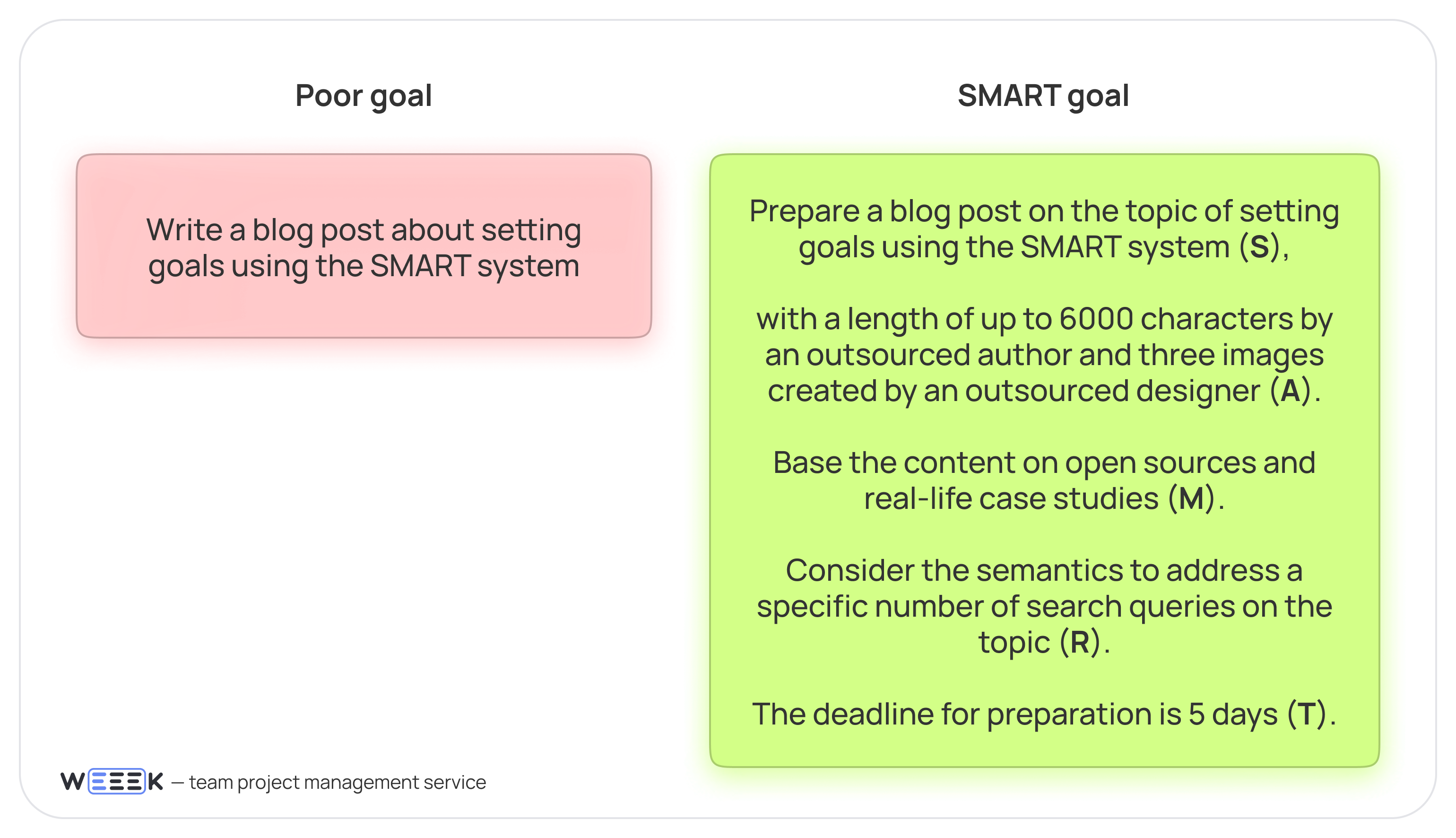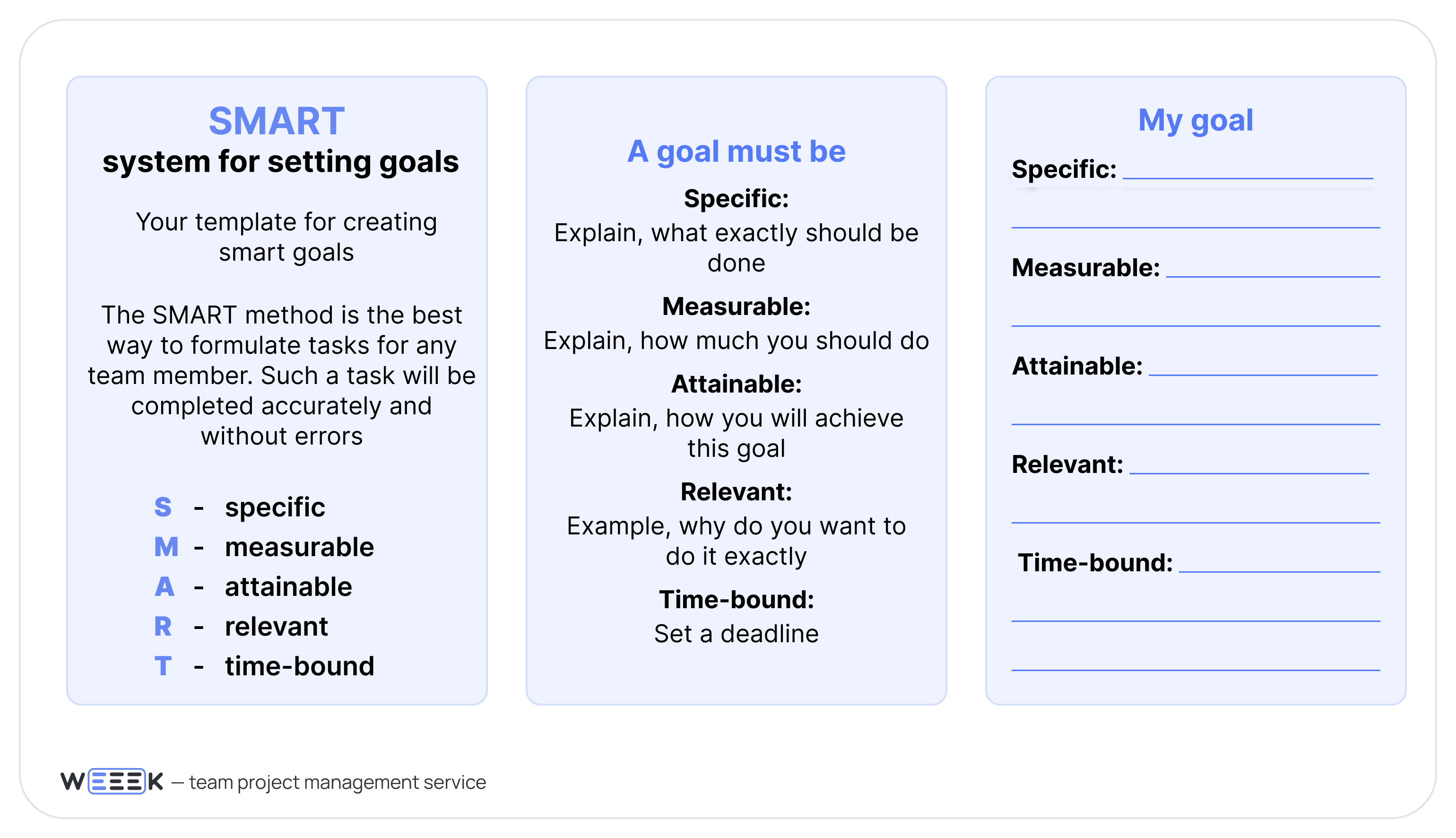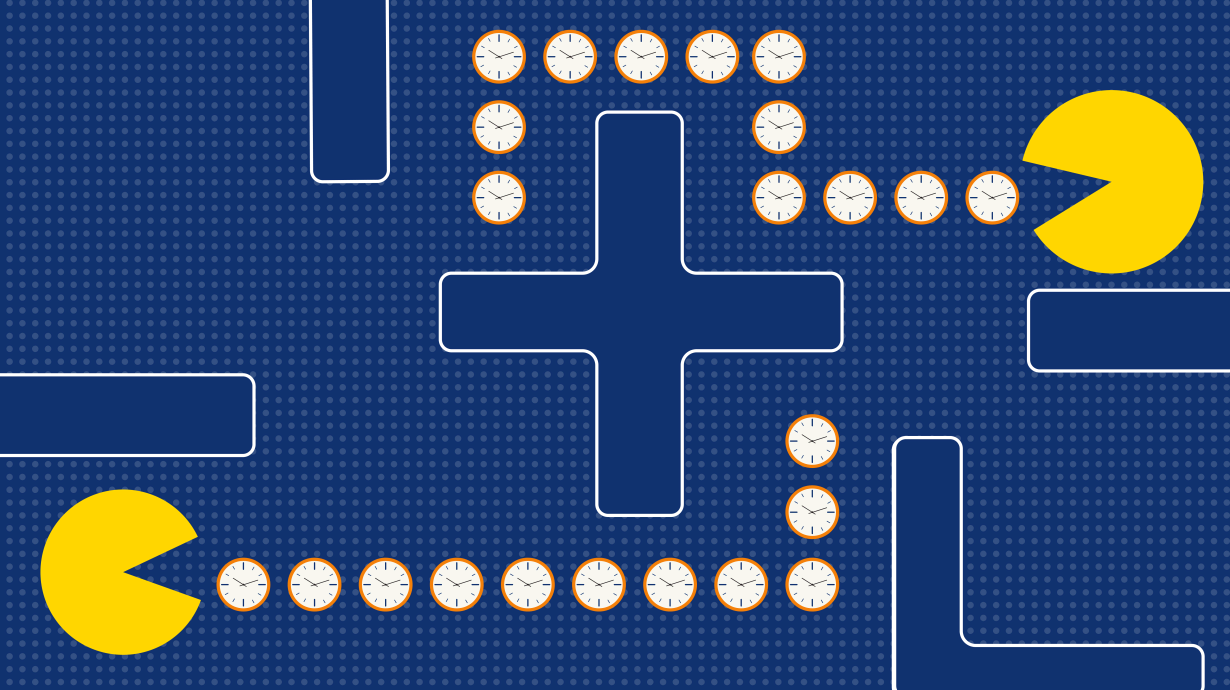"When you feel a goal is unattainable, don't change the goal—change your plan of action." This quote is often attributed to Confucius online. Whether it's true or not, the wisdom stands.
Here's something to add: if you can't reach a goal, it might not truly be your goal, or you might lack the right strategy. Reevaluate your goal and develop an effective strategy. The SMART method is a powerful tool for this, and I'll explain what it is and how to apply it.
What is the SMART Method and How Does It Work?
📌 SMART is a method designed to set and achieve goals with a high degree of certainty. The strength of the SMART approach lies in its acronym.

Let's break it down with an example.
Imagine you're opening a new branch of your company in another city. Your goal is to assemble a team of employees.
Here's how a SMART goal would look:
"Build a team in the new branch in city N (S) consisting of 5 top management specialists, 10 sales specialists, and 1 office manager (M) to launch the branch (R) in line with the others (A) by September 1, 2023 (T)."
Would this task be clear to an HR manager and completed on time? Definitely, because the goal is specific and well-defined. The likelihood of success? 99%. We'll leave 1% for human factors 😉
Key Criteria of the SMART System
Let's break down each criterion in detail:
S – Specific
Every goal should be defined as clearly as possible, with no room for ambiguity.
Verification question: What exactly needs to be done?
✅ For example: Assemble a team of employees; Increase sales; Secure a contract with a VIP client.
Formulate a clear and specific call to action. You can also apply the 3W rule:
- What: what do I need to do, or what do I want to achieve?
- Who: who will be responsible? The individual, department, or team?
- Where: where should this goal be achieved? Within the company, in a specific market, or within a department?
💡 A tip from WEEEK. To ensure clarity and conciseness, start describing the goal with a verb in its base form! This approach is particularly effective when assigning tasks to yourself and your team. Notice the difference: "an article about SMART goals" versus "prepare an instructional article on how the SMART method works."
M – Measurable
A goal should include metrics that clearly reflect progress and results. These are your business KPIs. To establish measurable indicators in SMART, consider these questions:
- What will be the progress indicator? Identify the key metrics.
- How much to achieve or increase? Base this on strategy and experience.
- How will I know I've achieved the goal? Which metric should change?
✅ An example of a goal incorporating the Measurable criterion: Assemble a sales team of 10 employees; Increase sales by 15% compared to the previous month; Secure a contract with a VIP client for 100,000 rubles.
A – Achievable
A goal should be realistic and attainable. Avoid setting arbitrary figures or desired outcomes without a basis. To determine if a goal is achievable, analyze past performance.
For instance, if you aim to increase sales by 15% next month, and your primary source of customer traffic is social media, analyze the traffic growth month over month.
Suppose social media brings in up to 10 new clients per month. You’ll need to explore strategies to attract more clients and boost traffic. Based on this data, you can set an achievable goal. You might realize that increasing sales by 15% would require a significant increase in your advertising budget, leading you to adjust the target to a more realistic 5–8% growth.
R – Relevant
Each goal should be a step towards achieving a larger objective. This criterion helps determine whether it's worth allocating resources to the goal.
Reflect on these questions:
- Why do I want to achieve this goal?
- What’s the purpose of this effort?
- How does achieving this goal fit into the overall strategy of the company?
For example, your company’s goal is to enter the international market, but the PR department starts collaborating with influencers who just recently relocated abroad.
Is this collaboration relevant? Likely not, as these influencers may not have gained a significant international audience yet, and their core following remains in their home country.
T – Time-bound
A goal must have a clear deadline.
Verification question: when do I want to achieve this goal?
💡 A tip from WEEEK. If the goal is new for your team, allow extra time for adaptation. Discuss with your team members how much time they’ll need to reach the goal. They may request more time than initially planned. Listen to their input and collaboratively decide on a realistic deadline.
How to Apply SMART for Goal Setting in Various Areas
The SMART method can be applied to any area—from personal life to major business deals. Now that you understand how the SMART methodology works, you can start using it effectively across different domains.
Let’s solidify this with examples of well-set SMART goals and compare them with poorly defined ones.
SMART Goal in Sales
❌ Poor Goal
To increase employee salaries and pay out quarterly bonuses, we need to boost sales.
✅ SMART Goal
Between September and November, increase the number of contracts with teams of up to 10 people by 5% and with teams of up to 30 people by 10%. By November 30th, secure at least 4 deals with VIP clients totaling 1,000,000 rubles. This will enhance company revenue and allow for further investment in growth.
SMART Goal in Personal Life
❌ Poor Goal
Go on vacation in the summer (a great goal, but not SMART).
✅ SMART Goal
Set aside 15% of your salary each month to purchase a travel package by the end of spring before prices rise. Then, take a two-week vacation in Egypt in mid-August and enjoy a well-deserved break!
SMART Goal in a Project
❌ Poor Goal
Increase the number of listeners for the podcast "I'll Finish It Later."
✅ SMART Goal
Increase the number of unique listeners for the podcast "I'll Finish It Later" by 5% compared to the previous month, while maintaining last quarter’s performance by focusing on analyzing popular topics and episodes.

Advantages of Using SMART
✅ Clear and Specific Goals. SMART goals provide a clear direction, making it easier to understand the required resources. When goals are specific, it’s also easier to adjust plans, ensuring the team stays focused and avoids confusion.
✅ Alignment with Company Strategy. SMART goals are designed to align with the broader company strategy, particularly through the relevance criterion. Each small goal contributes to the bigger picture, ensuring that every effort is purposeful.
✅ Identification of Unrealistic Goals. By making each goal time-bound, assigned to a specific individual, and measurable through KPIs, planning and monitoring become more straightforward. This makes it easier to spot which goals are achievable and who may need additional support.
✅ Enhanced Motivation and Predictability. SMART goals give the team clear boundaries—knowing exactly what needs to be done to succeed motivates them. This clarity also makes it easier to predict long-term and short-term outcomes, reducing uncertainty.
✅ Improved Task Prioritization. SMART planning is particularly effective for teamwork, as it helps clarify the importance of tasks. This prevents employees from getting stuck in routine tasks that don’t contribute to the main objectives.
Disadvantages of Using SMART
❌ Focus on Achievement at Any Cost. When goals are strictly defined by SMART, there’s a risk that employees might focus too much on hitting targets, potentially leading to burnout or neglecting other important aspects of life, such as health and relationships.
❌ Risk of Work Apathy. When the focus is solely on numbers and targets, the passion for the work can fade. Over time, the work may feel soulless, with KPIs becoming the only thing that matters.
❌ Endless Cycle of Goal-Setting. Employees may find themselves constantly chasing the next goal, with each new target needing to be more ambitious than the last. This can feel like an endless race, leading to stress and the sense of trying to achieve the impossible.
What is SMARTER?
Let’s explore the expanded version of SMART—known as SMARTER.
As methodologies evolve, there’s often a need to add additional principles. SMARTER includes two extra criteria:
- E – Evaluate. Regularly reassessing goals as you work towards them is crucial. This allows for adjustments based on progress and changing circumstances.
- R – Re-adjust. During the pursuit of a goal, unexpected challenges can arise. For instance, if the goal is new to the team, certain processes may need to be developed from scratch.
💡 A tip from WEEEK. As a leader, it’s important to periodically check in with your team to ensure everyone understands the goal and address any difficulties they may face.
For example, if a decision is made to temporarily reduce the advertising budget, you’ll need to revisit goals that were tied to that budget—either adjusting the expectations or postponing the goals. This proactive approach helps to prevent failures caused by unrealistic expectations.
✅ Imagine you set a goal to increase sales by 15%, but you’re barely reaching 5%, and your sales team is nearing burnout with the deadline approaching. The initial goal needs to be reassessed and adjusted to reflect the current reality.
In summary, SMARTER emphasizes flexibility and allows for course corrections, ensuring that goals remain realistic and achievable as circumstances change.
Tips for Effective Goal Setting from WEEEK
We've covered the SMART method for setting goals, so the next step is to choose the right tool for managing the process.
The methodology won't be effective if each employee sets goals individually on sticky notes or in notebooks. Tasks in messenger chats and other messengers can get lost and are difficult to track. The best solution is to implement a functional and flexible task manager to oversee tasks and processes within the team.
Here’s an overview of WEEEK features that will help you formulate and set goals using the SMART method.
Specificity (S) and Measurability (M). Start by clearly defining the goal and the metric you need to achieve. Create a primary task in the system.
Achievability (A) and Relevance (R). In the task's comments section, add other SMART criteria—such as the rationale behind the goal (R), analytics from similar past metrics, and attach relevant files (A).
Time-Bound (T). Set a time frame for achieving the goal. Subtask deadlines should be set for specific dates.
✅ And there you have it—a clear schedule for working on your SMART goal! The goal, its deadlines, and descriptions are all organized in one place.
Now, let's look at additional features needed for working on SMART goals:
- Subtasks. Use the subtask feature to outline micro-goals that contribute to the main SMART goal and assign team members to each.
- Responsible. You can assign the primary task to a manager and subtasks to other team members, such as developers or designers, and easily see who oversees the project and who is responsible for each part.
- Task Rescheduling. If a task isn’t completed by the deadline, the responsible person will receive a notification. Overdue tasks are marked with an icon.
- Prioritization. Set task priorities using color markers. Cards will be highlighted based on their priority level.
- Work Visualization. The Gantt chart feature helps visualize the work stages for your SMART goal. It displays the goal and subtasks, the progress of each stage, and the responsible team members.

At WEEEK, we believe that smart goal setting using the SMART method can be beneficial in any area—from company workflow and productivity to personal life and even AI interactions. SMART is a tool that helps you carve the granite of your tasks, without burying you and your team under its rubble.















